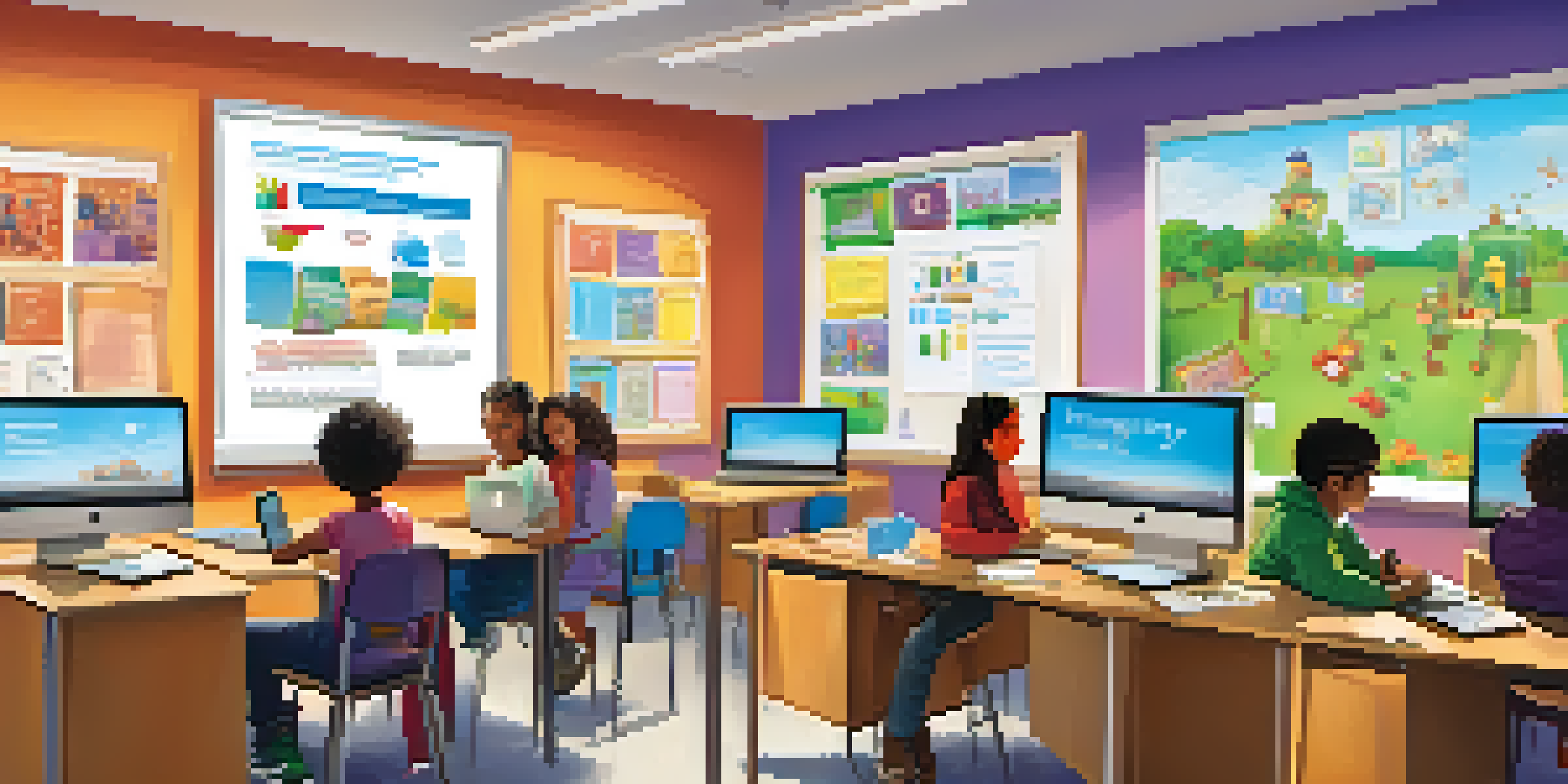The Importance of Digital Literacy in Education Today

Understanding Digital Literacy and Its Components
Digital literacy encompasses a range of skills necessary for navigating the online world, including the ability to effectively use technology, evaluate information, and communicate digitally. It’s not just about knowing how to operate a computer; it involves understanding online etiquette, recognizing credible sources, and utilizing various software tools. As technology continues to evolve, the definition of digital literacy expands, making it crucial for students to stay informed and adaptable.
Digital literacy is not an option, but a necessity for the future of education.
In today’s education system, digital literacy is foundational, much like reading or math. It equips students with the skills needed to succeed in both academic and real-world scenarios. For example, a student proficient in digital tools can easily research a topic, collaborate on projects, and present findings using technology, making them more competitive in the job market.
Moreover, digital literacy promotes critical thinking and problem-solving skills. Students learn to analyze information critically, discerning fact from misinformation, which is vital in an era where we are bombarded with content from various sources. This skill set not only helps them academically but also prepares them for responsible citizenship in a digital society.
The Shift to Online Learning Environments
The recent shift to online learning, accelerated by the pandemic, has underscored the importance of digital literacy. Many students found themselves unprepared for virtual classrooms, lacking the necessary skills to engage effectively with digital platforms. This scenario highlighted the disparities in access to technology and the varying levels of digital skills among students, prompting educators to rethink their approach.

As schools continue to incorporate technology into their teaching methods, digital literacy becomes vital for all students. Those who can confidently navigate online tools and platforms are better equipped to participate in discussions, collaborate on group projects, and access educational resources. This proficiency not only enhances their learning experience but also fosters a sense of independence and responsibility.
Digital Literacy is Essential
Digital literacy equips students with critical skills for academic success and responsible citizenship in a tech-driven society.
Furthermore, educators are challenged to integrate digital literacy into their curricula. This involves teaching not just how to use technology but also how to use it ethically and responsibly. By embedding these lessons into everyday learning, teachers can empower students to harness technology to their advantage, ensuring they are prepared for future challenges.
Preparing Students for the Workforce
Employers today seek candidates who possess strong digital skills, making digital literacy a crucial aspect of career readiness. Many jobs require familiarity with various software applications, online communication tools, and data management systems. By equipping students with these skills, educators help bridge the gap between education and employment.
The ability to think critically and creatively with technology is essential for success in the modern world.
For instance, students who learn digital marketing techniques or data analysis during their studies have a competitive edge in the job market. They enter the workforce not only with theoretical knowledge but also with practical skills that employers value. This preparation enhances their employability and increases their chances of career advancement.
Moreover, fostering digital literacy in students encourages lifelong learning. The digital landscape is constantly changing, and being adaptable is key to professional growth. When students are comfortable with technology, they are more likely to pursue ongoing education and training, keeping their skills relevant in an ever-evolving job market.
Enhancing Critical Thinking and Problem-Solving Skills
Digital literacy doesn't just empower students to use technology; it also enhances their critical thinking and problem-solving abilities. In a digital context, students are often required to analyze data, evaluate information sources, and make informed decisions based on their findings. This analytical approach is invaluable both academically and personally.
For example, when students engage in online research, they learn to sift through vast amounts of information, discerning credible sources from unreliable ones. This skill not only boosts their academic performance but also equips them to navigate the complexities of information in their daily lives. As they grow older, these skills will help them make informed choices in various scenarios, from health decisions to civic engagement.
Preparing Students for Careers
Strong digital skills enhance employability and career readiness, allowing students to thrive in the modern job market.
Furthermore, digital literacy fosters creativity and innovation. As students explore different digital tools, they can express their ideas in new ways, whether through multimedia presentations, blogs, or interactive projects. This creative outlet encourages them to think outside the box and develop unique solutions to problems, skills that are highly valued in today’s society.
Promoting Safe and Responsible Internet Use
Digital literacy also includes understanding how to navigate the internet safely and responsibly. This is crucial in a world where online threats such as cyberbullying, privacy breaches, and misinformation are prevalent. By teaching students about these risks, educators can help them become responsible digital citizens.
For instance, lessons on internet safety can include topics like recognizing phishing scams, protecting personal information, and understanding the implications of sharing content online. When students are aware of these issues, they can make informed choices that protect themselves and others in the digital space. This knowledge fosters a culture of respect and responsibility among peers.
Moreover, promoting digital citizenship encourages students to contribute positively to the online community. By understanding their rights and responsibilities, they can engage in constructive discussions, share valuable resources, and support their peers. This sense of community is essential in creating a safe and inclusive digital environment for everyone.
Supporting Diverse Learning Needs with Technology
Digital literacy can play a crucial role in supporting diverse learning needs among students. Technology offers a variety of tools and resources that cater to different learning styles, allowing for a more personalized educational experience. For example, students with learning disabilities can benefit from assistive technologies that facilitate their learning.
By incorporating digital tools into the classroom, educators can create inclusive environments where all students have the opportunity to thrive. For instance, visual aids, interactive simulations, and online resources can help students grasp complex concepts more easily. This adaptability not only enhances engagement but also promotes equity in education.
Fostering Safe Internet Use
Teaching responsible internet navigation helps students become respectful digital citizens, aware of online risks and ethical practices.
Additionally, technology can connect students with resources beyond their immediate environment. Online programs and platforms can provide access to specialized tutoring, mentorship, and collaborative projects with peers from around the world. This exposure enriches their learning experience and fosters a sense of community that transcends geographical boundaries.
The Future of Education and Digital Literacy
As we look to the future, the importance of digital literacy in education will only continue to grow. With rapid technological advancements and an increasingly interconnected world, students must be prepared to navigate the challenges and opportunities that lie ahead. This preparation begins with a strong foundation in digital skills during their formative years.
Incorporating digital literacy into curricula is not just a trend; it’s a necessity for modern education. Schools and educators must prioritize teaching these skills alongside traditional subjects to ensure that students are well-rounded and equipped for the complexities of the future. This approach not only benefits individual learners but also contributes to a more informed and capable society.

Ultimately, fostering digital literacy in education is about empowering students to thrive in a digital world. By equipping them with the skills they need to succeed, we enable them to become informed citizens, creative thinkers, and responsible digital citizens. As we embrace the future, let’s commit to prioritizing digital literacy for every student.